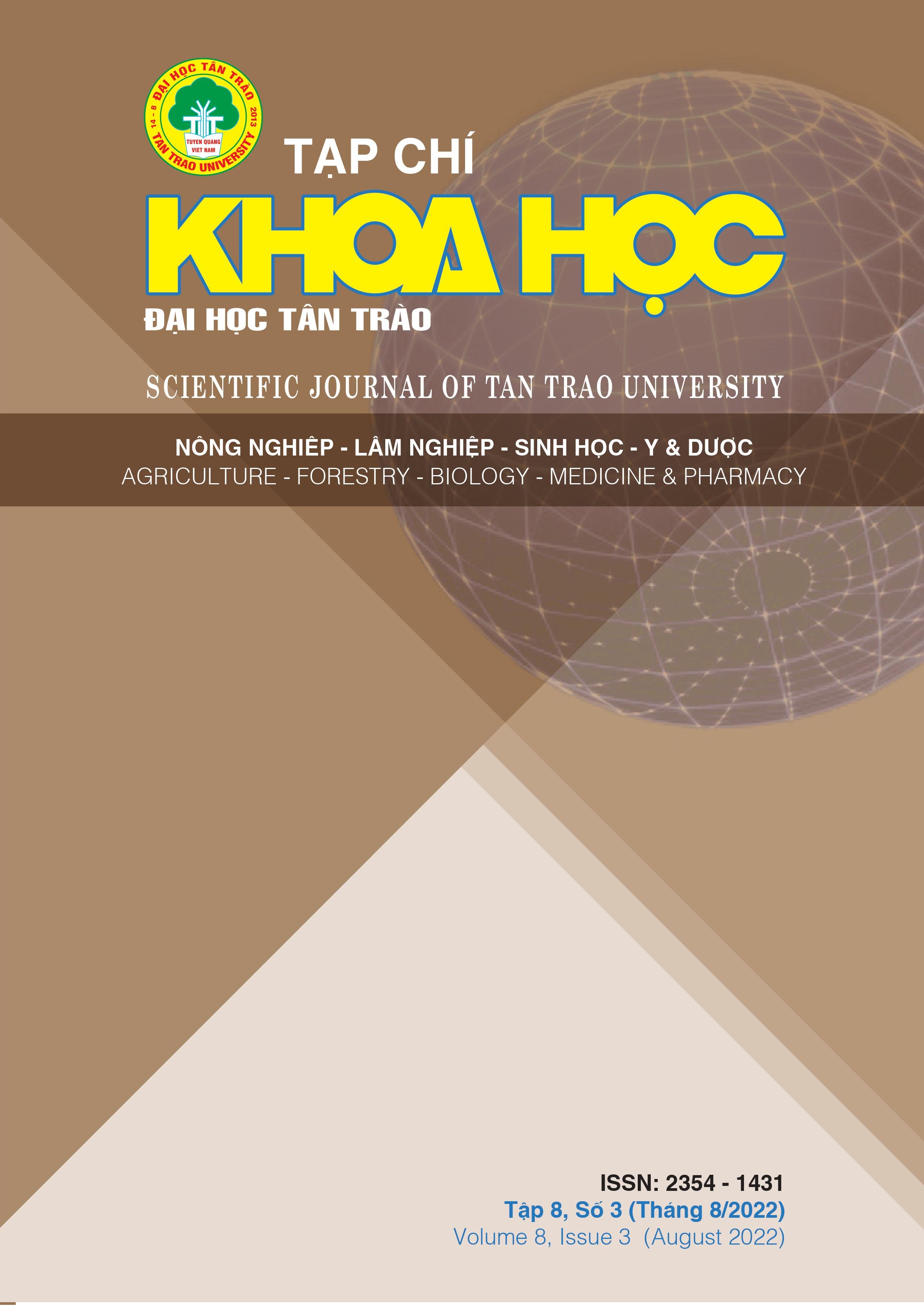ANTIBIOTIC SUSCEPTIBILITY OF ACINETOBACTER BAUMANNII STRAINS ISOLATED IN SOME VIETNAMESE HOSPITALS IN THE PERIOD 2017-2019
Keywords:
Acinetobacter baumannii, MIC, antibiotic resistance, carbapenem, colistinAbstract
The study was to determine the Minimum Inhibitory Concentration (MIC) of 157 Acinetobacter baumannii strains isolated on inpatients from 6 hospitals in Vietnam including: Huu Nghi Hospital , Hospital 108, Thanh Nhan Hospital, Saint Paul Hospital, Hue Central Hospital, Can Tho Provincial General Hospital in the period 2017-2019. MIC results showed that A. baumannii was resistant to ≥ 77% to 8/9 tested antibiotics; 91% of A. baumannii were resistant to both carbapenem antibiotics, meropenem and imipenem, with MIC50 of 32 - 64 µg/ml and MIC90 ≥ 64 µg/ml. The lowest resistance rate was colistin (34,3%) and the MIC range of colistin ranged from < 0,25 - ≥ 4 µg/ml; MIC50 = 1 µg/ml, MIC90 = 4 µg/ml. Research results are the basis for clinical pharmacists and treating doctors to calculate an effective and safe treatment dose that is appropriate for the patient.
Downloads
References
[1]. Wareth G, Linde J, Nguyen NH, et al (2021). WGS-Based Analysis of Carbapenem-Resistant Acinetobacter baumannii in Vietnam and Molecular Characterization of Antimicrobial Determinants and MLST in Southeast Asia. Antibiotics; 10: 563.
[2]. Tacconelli E, Carrara E, Savoldi A, et al (2018). Discovery, research, and development of new antibiotics: the WHO priority list of antibiotic-resistant bacteria and tuberculosis. The Lancet Infectious Diseases; 18: 318–327.
[3]. P.T.N.Thao, T.V.Ngoc, T.T.T.Nga (2017). Investigation of drug resistance characteristics of Pseudomonas aeruginosa and Acinetobacter baumannii causing hospital-acquired pneumonia. Medical news; 64–69.
[4]. Hoang Quoc C, Nguyen Thi Phuong T, Nguyen Duc H, et al (2019). Carbapenemase genes and multidrug resistance of Acinetobacter baumannii: A cross sectional study of patients with Pneumonia in Southern Vietnam. Antibiotics (Basel); 8: E148.
[5]. Phu VD, Wertheim HFL, Larsson M, et al (2016). Burden of Hospital Acquired Infections and Antimicrobial Use in Vietnamese Adult Intensive Care Units. Plos ONE; 11: e0147544.
[6]. T.Đ.Hung, T.L.Son, T.T.Dung et al (2022). Introduction rate and antibiotic resistance of Acinetobacter baumannii isolated from respiratory diseases Can Tho city general hospital 2021. Vietnam Medical Journal; 515(2): 338-342
[7]. L N Khue (2017). Practical guide to clinical microbiology testing techniques. Medical Publishing House.
[8]. Patel JB (ed) (2017). Performance standards for antimicrobial susceptibility testing. 27th edition. Wayne, PA: Clinical and Laboratory Standards Institute.
[9]. Koeth LM, DiFranco-Fisher JM, McCurdy S (2015). A Reference Broth Microdilution Method for Dalbavancin In Vitro Susceptibility Testing of Bacteria that Grow Aerobically. Journal of Visualized Experiments: JoVE. Epub ahead of print 9 September. DOI: 10.3791/53028.
[10]. Hsu L-Y, Apisarnthanarak A, Khan E, et al (2017). Carbapenem-resistant Acinetobacter baumannii and Enterobacteriaceae in south and southeast Asia; 30: 1–22.
[11]. Thanh LNX, Ngọc LTÁ, Liên NTN, et al (2017). Molecular characterization of genes encoding acquired carbapenemase of carbapenemresistant Acinetobacter baumannii isolates. Journal of Medicine and Pharmacy; 7: 52.
[12]. P.H.Nhung, Đ.X.Co, B.T.Hao (2017). Antibiotic susceptibility of gram-negative bacilli isolated in the intensive care unit of Bach Mai hospital. Medical research journal; 109: 1–8.
[13]. Kim DH, Choi J-Y, Kim HW, et al (2013). Spread of Carbapenem-Resistant Acinetobacter baumannii Global Clone 2 in Asia and AbaR-Type Resistance Islands. Antimicrob Agents Chemother; 57: 5239–5246.
[14]. Magiorakos A-P, Srinivasan A, Carey RB, et al (2012). Multidrug-resistant, extensively drug-resistant and pandrug-resistant bacteria: an international expert proposal for interim standard definitions for acquired resistance. Clinical Microbiology and Infection; 18: 268–281.
[15]. Tuan Anh N, Nga TVT, Tuan HM, et al (2017). Molecular epidemiology and antimicrobial resistance phenotypes of Acinetobacter baumannii isolated from patients in three hospitals in southern Vietnam. Journal of Medical Microbiology; 66: 46–53.
[16]. LTVNga, PHNhung, TT VPhuong, et al (2020). The relationship between the degree of carbapenem resistance and the occurrence of carbapenemase-encoding genes of Acinetobacter baumannii strains isolated in some hospitals. Vietnam Science and Technology Magazine; 62 (7): 35-39
. Tran DN, Tran HH, Matsui M, et al (2017). Emergence of New Delhi metallo-beta-lactamase 1 and other carbapenemase-producing Acinetobacter calcoaceticus-baumannii complex among patients in hospitals in Ha Noi, Viet Nam. Eur J Clin Microbiol Infect Dis; 36: 219–225.
[18]. Linh TK, Van CTB (2017). The situation of colistin resistance in some common Gram-negative bacteria in hospital infections in Ho Chi Minh City. Medical Journal of Ho Chi Minh City; 8.
[19]. Osei Sekyere J. Mcr (2019). Colistin resistance gene: a systematic review of current diagnostics and detection methods. MicrobiologyOpen; 8: e00682.
[20]. Hui Li, Hua Zhou, Xi Li, Jianfeng Wang, Ying Fu, Yan Jiang, Yunsong Yu (2018). The Evaluation of Four In Vitro Susceptibility Testing Methods for Colistin on Carbapenenm-Resistant Acinetobacter baumannii. Jundishapur journal of microbiology; 10.
[21]. Matuschek E, Åhman J, Webster C, et al (2018). Antimicrobial susceptibility testing of colistin – evaluation of seven commercial MIC products against standard broth microdilution for Escherichia coli, Klebsiella pneumoniae, Pseudomonas aeruginosa, and Acinetobacter spp. Clinical Microbiology and Infection; 24: 865–870.
Downloads
Published
How to Cite
Issue
Section
License

This work is licensed under a Creative Commons Attribution-ShareAlike 4.0 International License.
All articles published in SJTTU are licensed under a Creative Commons Attribution-ShareAlike 4.0 International (CC BY-SA) license. This means anyone is free to copy, transform, or redistribute articles for any lawful purpose in any medium, provided they give appropriate attribution to the original author(s) and SJTTU, link to the license, indicate if changes were made, and redistribute any derivative work under the same license.
Copyright on articles is retained by the respective author(s), without restrictions. A non-exclusive license is granted to SJTTU to publish the article and identify itself as its original publisher, along with the commercial right to include the article in a hardcopy issue for sale to libraries and individuals.
Although the conditions of the CC BY-SA license don't apply to authors (as the copyright holder of your article, you have no restrictions on your rights), by submitting to SJTTU, authors recognize the rights of readers, and must grant any third party the right to use their article to the extent provided by the license.


